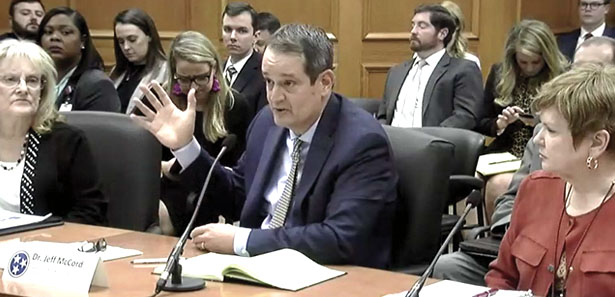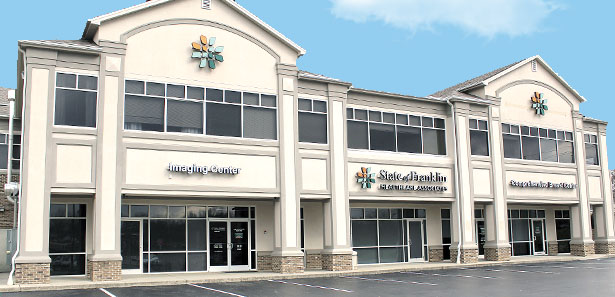Above: McCord testifies at budget hearings. FILE PHOTO
Tennessee Commission of Labor and Workforce Development
The Business Journal: When you took this job, you had no way of knowing you would end up dealing with the fallout from a pandemic. Now, it falls to your department to help Tennessee citizens and businesses in an environment of relatively high unemployment rates and improvable workforce participation rates, but also a quarter million unfilled jobs. The administration has just unveiled a campaign called “Let’s Get to Work, Tennessee.” What’s the strategy?
Commissioner Jeff McCord: It’s multi-pronged. We are doing things we haven’t done before. I’ll give you some examples. We have begun to work with the Tennessee Higher Education Commission (THEC) to get information about people on unemployment insurance and their eligibility for Tennessee Reconnect. Our first look at that shows about 500,000 people who could improve their job skills and move. So, yes, there are a quarter million open jobs, but there’s the question of how to qualify for those jobs, and that’s actually one of the same questions we went into this with: how to move folks from low-paying jobs into a pathway to higher-paying jobs.
For us, there’s an opportunity here, because we have had huge disruptions in service industry jobs and those are exactly the kinds of jobs we’re trying to transition folks from into higher-wage jobs. So, within the calamity, there is opportunity.
We’re doing the very same thing with our adult ed population. So, THEC is now getting information just like they would from a high school for folks who were either graduating or scoring high on initial tests. Information is now flowing freely to our local regions so they can execute on moving people to jobs. There are hundreds of job fairs going on online across the state. We now have more apprentices in Tennessee than we have had in the last decade, and the reason I can only say that is because our data only goes back a decade. So as far back as we can see, we have more apprentices now than we have ever had, and that’s during a pandemic.

I will be on the phone today, tomorrow and next week with faith-based communities in every region of the state to engage them and come alongside them for both their members and the people they serve to help them help us connect the services – both in things like job placement services and resume writing as well as in spreading awareness that we can give people additional job training. Internally, we’re calling the whole effort “Re-employ Tennessee.” So, as you can see, there are a lot of multipronged strategies with a lot of other partners to make that happen.
The data is getting better. We had a high of 15 percent unemployment. The last numbers that came out, we were at 5.3 percent, and our labor participation rate has been rising as well. So, there are some positive signs.
BJ: The administration recently reconstituted the state Workforce Development Board. What was the reasoning behind that?
JM: That is all about our federal partners wanting us to have a different structure. For example, the adult ed assistant commissioner is now on that board. We thought it would suffice that since that assistant commissioner reports to me that I can speak for that commissioner, but the fed said, “No, we need to have that certain position.” Since there’s a required ratio between private and public, every time you add somebody from the public you need to add a private position as well.
BJ: I did note that if you wanted to catch a ride home from Nashville to northeast Tennessee with somebody on that board, you would only be able to get as far as Morristown. There’s nobody but you from northeast Tennessee on that 33-member board.
JM: These are appointments by the governor, and I am aware of the fact that carpooling is not a great option for me. We’ll be working on that as we go forward. Representation from northeast Tennessee is certainly on my mind.
BJ: Let’s talk about the status of the extended federal unemployment benefits relating to the CARES Act: the PUA, PEUC, FPUC, that entire alphabet soup. What is Tennessee actively participating in now?
JM: So, TUC is Tennessee benefits. That lasts 26 weeks. It’s key here to understand that TUC is paid by the employer and they earn eligibility through work history. That’s typically how unemployment insurance works. So basically, people have to work two quarters to earn eligibility into the program.
In a typical time frame, only about 60 percent of people who apply for unemployment insurance actually are eligible, just like any insurance. That is what we went into this thing with. The first thing that came about (from the federal government) was PUA or Pandemic Unemployment Assistance, which covered people who were W-2 wage earners, which is the only thing TUC ever covers. So, the federal government had the PUA and that the PUA lasted 39 weeks. This new legislation extends that another 11 weeks.
Then there’s the PEUC, which kicks in after you run out of your Tennessee benefit and extends it from 26 weeks to 39 weeks. Now, they have extended that another 11 weeks for a total of 50 weeks for the PUA and the PEUC.
Then there’s the FPUC which ended, but has picked up again in January. It used to be $600. Now it’s $300, and it’s only for 11 weeks. We started paying those Jan. 4. The president didn’t sign the legislation approving that until the previous Sunday, which meant some folks ran out of their 39 weeks, and so in a day or two, we’ll have a solution to get those folks back in for that new 11 weeks. There are only a few other states who are already distributing benefits.
The last program is something called MEUC, which stands for Mixed Earners Unemployment Compensation. It is a brand-new program on top of all the other programs. If you have both W-2 wages and 1099 wages to a certain level, it will give you an extra $100. We’re working on putting that into place right now. We opted into that program.
BJ: Has the availability of all these benefits been a factor in Tennessee businesses being unable to fill these 240,000+ jobs?
JM: We have heard that in feedback from businesses. We have heard stories, anecdotally. I don’t have any database on that, but we talk to businesses all the time and the wage pressure – the competition is how they put it – that we are providing them is causing them issues. So, the feedback we get from businesses is, “yes.”
BJ: We began this discussion by asking about the pandemic, and what you had no way of preparing for when you took office. Let’s end by talking about what you were prepared for. Where is your department on the issues and programs that were the administration’s pre-COVID priorities on labor and workforce development?
JM: Our marching orders really are the same now – to develop pipelines to serve current businesses and to foster economic development. That has accelerated because there is a new opportunity in business disruption.
Apprenticeship, for instance, was one of our top priorities, front and center. We had a four-year goal which we met in the first year. But also, we have some things that have slowed down that are still very important: workplace learning for high schools, for instance. The issue is not that we don’t have a structure. It’s just with the disruption in attendance of high schools because of the pandemic. We had been on a very strong path there. One of the hurdles had been that employers worried that if they took 16- or 17-year-olds onto their factory floor, they were going to run afoul of the government. Well, our department is the one you would run afoul of, so we put a consulting function in place. Since employers didn’t know, for the most part, what they could and couldn’t do, our workload in that consulting function went through the roof. It hasn’t been through the roof lately, but we anticipate it will pick back up.
Whenever you start a job, there will always be unexpected things, there will be disruption. In this case, I think we will be at a million claims filed soon. Usually, we would pay $200 million in unemployment benefits in a year. Last year, from March to December, we paid more than $6 billion. So, there has been a very strong emphasis on distributing benefits to help people get to the other side, and as we get to the other side, the charge is still the same.




